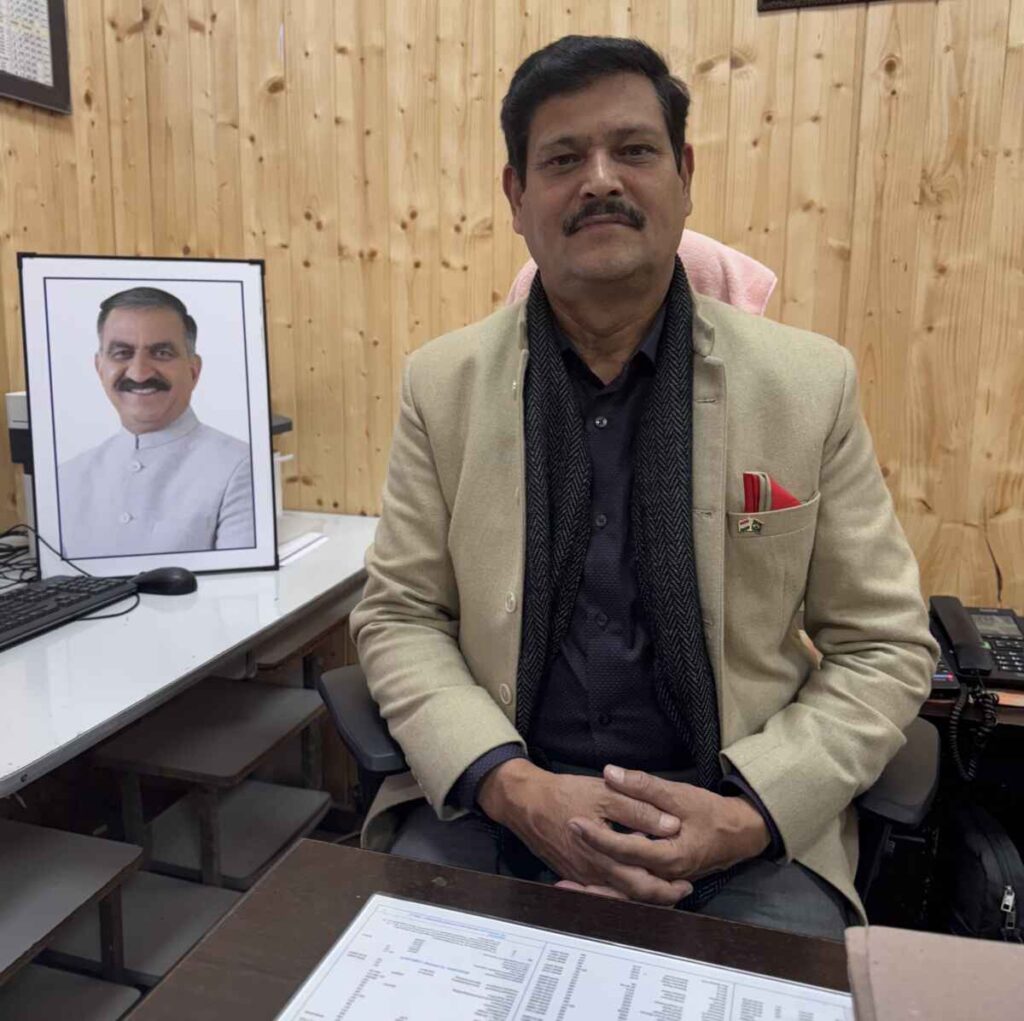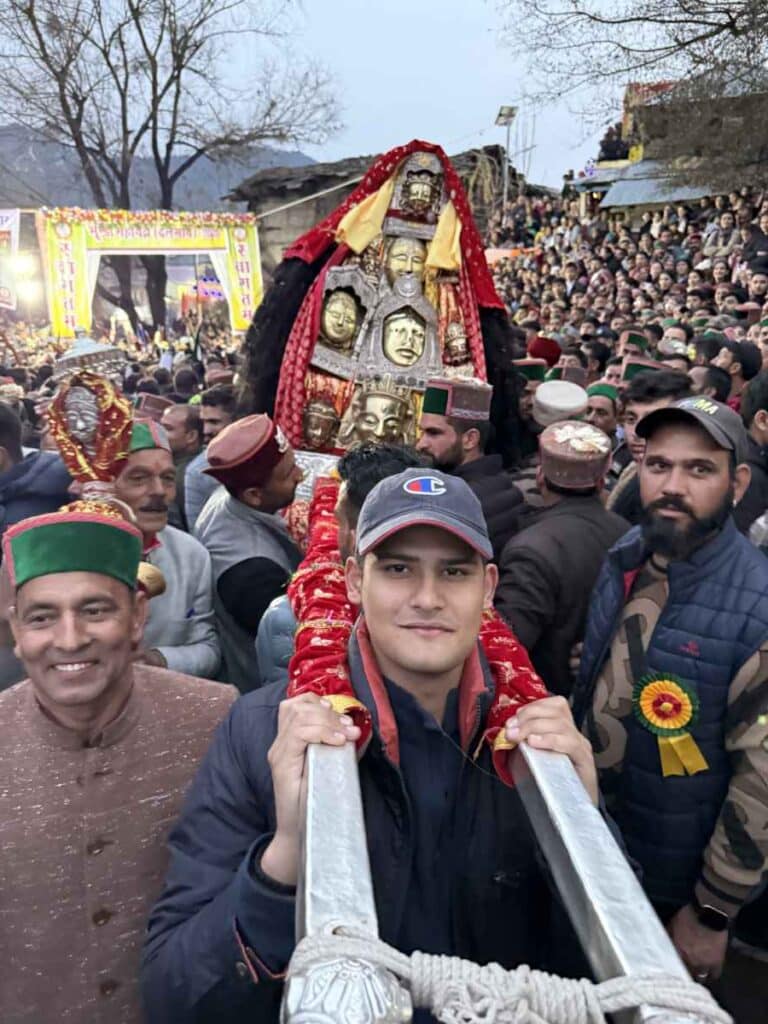On a crisp winter morning in Shimla’s serene Spail Valley, a sense of divine anticipation filled the air. Villagers and devotees from across Himachal Pradesh had gathered to witness the grand Bhunda Mahayajna, a once-in-a-lifetime event that weaves together myth, devotion, and heritage. Held after a gap of nearly four decades, this year’s Mahayajna has become the heart of discussions and preparations in Rohru and its surrounding areas. Revered as the “Kumbh of Rohru,” the event transcends its religious significance, symbolizing the region’s rich cultural fabric.
The Beda Ritual: A Triumph of Faith
On January 4, the Beda ritual, the most anticipated moment of the Bhunda Mahayajna, took place amidst a crowd that was both anxious and elated. Surat Ram, a 65-year-old man who has become a living legend in these parts, performed the ritual for the ninth time. For those present, it was more than just a physical feat—it was the culmination of decades of devotion, discipline, and spiritual preparation.
Surat Ram’s connection to the Bhunda Mahayajna dates back to 1985, when he first crossed the gorge as a 21-year-old participant in the same ritual. He has since become the face of the Beda, a figure whose dedication to the sacred task has inspired countless others. As he prepared to take his place on the rope, the atmosphere was charged with reverence.
“Every time I cross this gorge, it feels like a renewal of my connection with the divine,” Surat Ram shared with those around him just before stepping onto the sacred Munj rope. “It’s not about the physical act of crossing; it’s about surrendering to the will of the Almighty and the energies that surround us.”
The rope itself, a lifeline connecting the two cliffs, was a work of art. Made from Munj grass, a soft and sacred variety found only in this region, it had been meticulously crafted by Surat Ram and his four assistants over two and a half months. The sacred rope is a symbol of the serpent in the mythological tale of Lord Parshuram and the Beda. As Surat Ram made his way across the gorge, his every step was an embodiment of that myth—a connection between the mortal world and the divine.
A Life of Discipline
For months leading up to the ritual, Surat Ram had adhered to a life of strict discipline. Living in isolation at the Bakralu Maharaj Temple, he followed the time-honored practices required of a Beda participant. His diet was simple: a single meal a day, prepared within the temple grounds. He observed silence for the most part, refrained from cutting his hair or nails, and maintained celibacy.
“It’s not easy,” he admitted. “But it’s the way we prepare ourselves to carry out the sacred task. It’s about purifying the mind, body, and soul to ensure that the ritual is performed with the utmost respect and devotion.”
His assistants, too, had undergone similar preparation, living alongside him in the temple and dedicating themselves fully to the cause. It was a communal effort, with each individual playing a crucial role in ensuring that the ritual was carried out flawlessly.

Col. Kuldeep Banshtu, a retired officer of the Indian Army, currently serves as the Officer on Special Duty (OSD) to Himachal Pradesh Chief Minister Shri Sukhwinder Singh Sukhu, recounts the origins, transformation, and significance of this remarkable tradition. His words weave a vivid tapestry of history, spirituality, and community, revealing how the Bhunda Mahayagya continues to shape lives across generations.
The Genesis of the Bhunda Mahayagya
To understand the Bhunda Mahayagya, one must first delve into its ancient origins. According to Col. Banshtu, the roots of this ritual can be traced back to the village of Nirmand, where Parshuram, a revered deity, established societal norms and traditions. “When Parshuram ji settled the people in Nirmand, he ordained a Narmedha Yajna every twelve years, as per the Yajurveda,” he explains.
The Narmedha Yajna involved a unique ritual that required a person to slide down a rope, a practice known as “Beda.” Over time, this ritual evolved and spread to other regions. “It is said that an event involving Beda occurred in Rohru. On their way back to Nirmand, the participants were forced to halt in our village due to heavy snowfall,” he recounts.
Stranded and ill-equipped to face the harsh weather, these travelers were aided by the villagers, who crafted shoes out of goat hair to protect their feet. “Shoes were not readily available then,” says Col. Banshtu. “Our elders used goat hair to make shoes, allowing the travelers to continue their journey after three or four days.”
Grateful for this act of kindness, the travelers returned to Nirmand and spoke highly of the villagers. In recognition, the deities of Nirmand gifted a ceremonial umbrella to the village’s Ishtdevta (presiding deity) and passed on the responsibility of hosting the Bhunda Mahayagya to them. Thus, a tradition was born.
The Bhunda of 1985: A Personal Memory
The Bhunda Mahayagya has been celebrated for centuries, but Col. Banshtu vividly remembers the event of 1985, a year that left a lasting impression on him. “I was in college at the time, and the Bhunda was a grand affair,” he recalls. Despite the lack of modern infrastructure, people from far and wide came to witness the event.
“Back then, there were no proper roads or transportation facilities. Yet, the turnout was incredible,” he says. The 1985 Bhunda, like its predecessors, was a symbol of unwavering faith and devotion. People braved all odds to participate, walking miles to offer their prayers and witness the rituals.
In contrast, the Bhunda of 2025 has benefitted from significant advancements in infrastructure. “Today, roads, transportation, and other facilities are much better, making it easier for people to attend,” notes Col. Banshtu. Despite these changes, one thing remains constant: the deep faith of the people in their deities.
Faith and Transformation
When asked about the differences between the Bhunda of 1985 and the one held in 2025, Col. Banshtu reflects on the evolving nature of the tradition. “The positive change is the increasing faith in our Devas and Devatas,” he says. “The crowd has grown, and the participation is more organized.”
However, he acknowledges that modernization has brought its challenges. Environmental concerns have led to restrictions on certain practices that were once central to the ritual. “The eco-awareness movement has imposed limitations on activities involving animals. While this is a good thing, it has also changed some aspects of the Mahayagya,” he explains.
The temple committee, responsible for organizing the event, has adapted to these changes while staying true to the core principles of the ritual. “Whatever steps need to be taken, they are done according to the orders of the deities,” says Col. Banshtu. “The good thing is that society has become more aware and is taking steps against cruelty and unnecessary sacrifices.”
The Cultural Significance
Beyond its spiritual importance, the Bhunda Mahayagya serves as a cultural cornerstone for the region. Col. Banshtu elaborates on how the event brings people together, creating a sense of unity and belonging. “The Mahayagya is a time when families, scattered across the globe, reunite,” he says.
He paints a vivid picture of the gathering: children studying abroad return home, reconnecting with relatives and friends. “It’s a chance for the younger generation to meet their extended families and learn about their roots. They see how rituals are performed, understand their significance, and experience the vibrant cultural legacy of our region,” he adds.
The event also features fairs, music, and dance, showcasing traditional instruments and art forms. “It’s a celebration of life, culture, and community. People not only reconnect with their heritage but also strengthen their social bonds,” says Col. Banshtu.
Breaking Barriers: A Step Towards Equality
While the Bhunda Mahayagya is steeped in tradition, it has also become a platform for social change. One of the most notable transformations is the effort to break down caste barriers. “Historically, caste divisions played a significant role in determining who could participate in certain rituals,” explains Col. Banshtu.
However, recent years have seen a shift towards inclusivity. A new temple in the village now welcomes people of all castes and religions, allowing everyone to worship without discrimination. “We established a Shivling with the deity’s permission, where people of all backgrounds can come together to pray,” he says.
This move, while groundbreaking, respects the traditions of the deities while fostering a sense of equality among the villagers. “We want to eliminate casteism in our community. As human beings, we are all equal. This is the message we aim to spread through our actions,” asserts Col. Banshtu.
The Bhurnas: Keepers of Tradition
A unique aspect of the Bhunda Mahayagya is the role of the Bhurnas, individuals from a specific caste who perform the daring rope-slide ritual. This practice, which dates back to the British era, is a key highlight of the event.
“The Bhurnas of a particular caste are selected to slide on the rope. It’s a tradition that has been passed down through generations,” explains Col. Banshtu. He describes the meticulous process involved in the ritual: the Bhurna is carried to the rope on the shoulders of men and does not touch the ground until the ceremony is complete.
This act, both sacred and symbolic, underscores the community’s devotion and the Bhurna’s role as a bridge between the mortal and divine realms.
Preserving a Legacy
As Col. Banshtu reflects on the Bhunda Mahayagya, he marvels at its enduring relevance in a rapidly changing world. “This tradition is a reminder of our shared history and values,” he says.
The Mahayagya is not just a ritual but a celebration of humanity, resilience, and unity. It connects generations, bringing people together to honor their past while embracing the future. “In these mountains, amidst the changing times, the Bhunda remains a beacon of faith and hope,” says Col. Banshtu.
As the chants of the Mahayagya echo through the valleys, they carry with them a timeless message: that traditions, when nurtured with faith and inclusivity, have the power to illuminate lives and strengthen communities.
As the final moments of the Bhunda Mahayajna unfolded, there was a sense of fulfillment in the air. The sacred rope, the Beda, the spectators—all of it was part of a living legacy that connected the present with the past, the mortal with the divine.
For many, the event was a profound spiritual experience.
As the event drew to a close, the air was filled with songs of devotion, the sounds of the community celebrating together, and the quiet prayers of those who had witnessed a living piece of history. The Bhunda Mahayajna had not only revived an ancient tradition but had also reaffirmed the enduring power of faith, community, and culture. It was a moment that would be cherished for generations to come.
